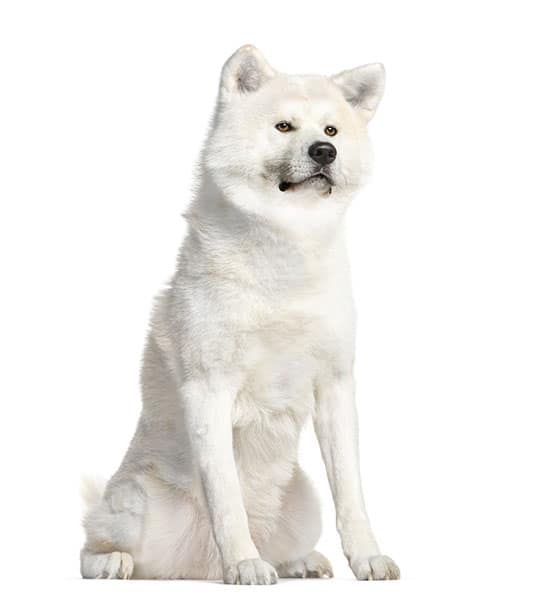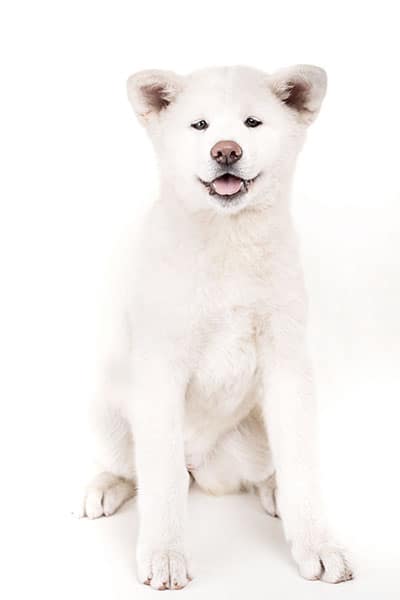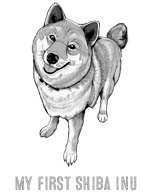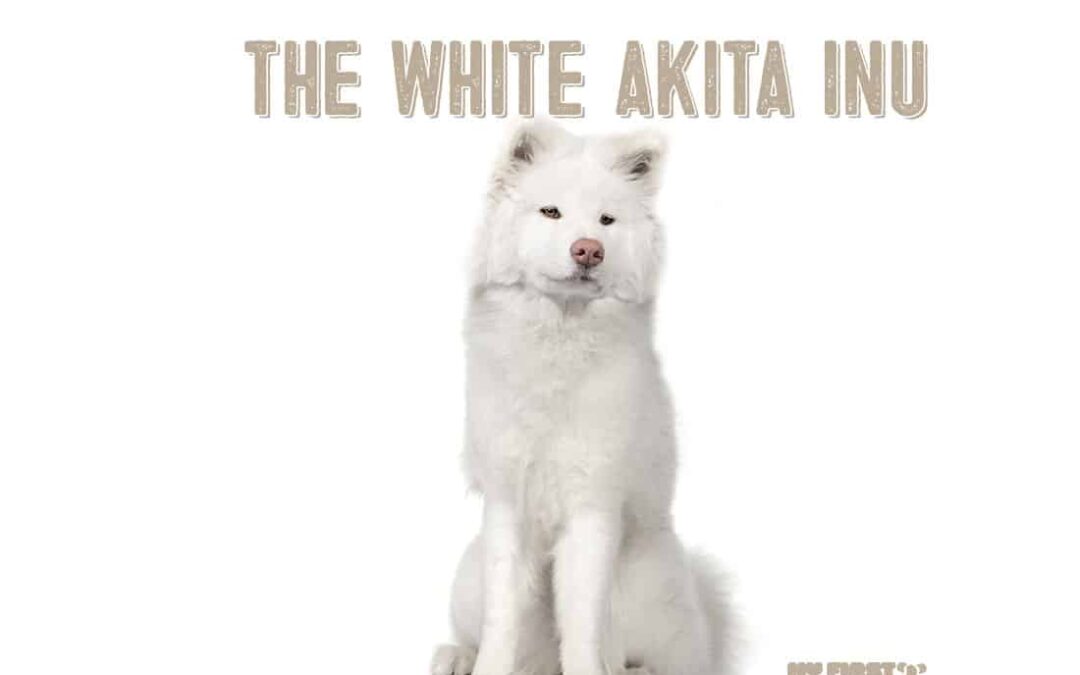On occasion, our posts contain affiliate links. However, we only recommend products that we truly believe in. For more information, visit my privacy policy page.
Phew, this website is a labor of love and largely a one-woman show so unless indicated, all articles written by J.Tsukamoto
The white Akita Inu is a beautiful dog possessing a vibrant white coat.
While more commonly appearing in Japanese Akita lines, white Akita Inus can also be found in the American Akita lines - though not very often.
Read on to learn the history as well as interesting facts about this beautiful dog breed.
History of the White Akita Inu
The white Akita Inu enjoys a storied history dating back to the regal times of Japanese Emperors and Empresses hundreds of years ago.
Back then, white Akita Inus are highly regarded as being “purer” dogs because at that time no foreign dogs were seen having all white coats.
Akita’s lost this purity when it was crossbred with the Tosa fighting dog of Japan.
The first Japanese organizations formed to preserve Akita Inus as well as other Japanese dog breeds formed in 1927.
At first, most Japanese breeders simply wanted to preserve their fighting dogs. It was not until a few years later did their perspective change to preserving individual Japanese dog breeds instead.
One of the very first Akita Inu to arrive in the United States was actually a gift to Helen Keller from Ichiro Ogasawara of Odate, an official of the Akitainu Hozonkai (Akiho).
Keller actually visited Japan and heard about the touching story of Hachiko the Akita Inu. She then mentioned how she would love to own a loyal dog like Hachiko one day.
When Japanese people in the town heard of it, they enlisted Ichiro to help make her dreams become a reality.
Sadly the very first Akita sent to Keller passed away before eight months due to distemper. The Japanese townspeople again enlisted Ichiro to send the brother of deceased Akita as a replacement.

White Akita Inu Coat Characteristics
Akita Inus with white coats should be brightly colored white with no off color tinting throughout the body.
According to The Japanese Akita Inu Club of America, a white Akita coat should be pure and vibrant like fresh snow.
In show ring circles, biscuit coloring on the white Akita’s ears, rear legs, back, shoulders, and tail are considered faults.
This means dull, dingy, muddy white is not desirable.
Generally most Japanese breeders agree that it will take about five generations of all white Akita Inus breeding to produce litters that are all white.
Temperament and Personality of the White Akita
Did you know that the color of a dog’s coat can affect the temperament of a dog?
Well according to researchers at Canine Genetics and Epidemiology, it’s true.
Their studies indicate that “chocolate-coated” Labrador retrievers are anecdotally considered to be less trainable and more hyperactive and aggressive than yellow or black labs.
Fortunately, the coat colors of Akitas do not affect their temperament.
Instead, temperament differences can be found between American Akita Inus and Japanese Akita Inus.
How Big Do White Akita Inus Get?
White Akita Inus are usually produced by the Japanese Akita line. This means that white Akita Inus are typically a bit smaller than American Akita Inus.
White Japanese Akita Inu weigh between 65-75 pounds and stand about 25-27.5” tall (males). Females are a bit smaller.
Compare this to an American Akita Inu that can weigh as much as 100-130 pounds (male), standing 26-28”!

Health and Lifespan of the White Akita
White Akita Inus do not suffer any health issues solely based on the color of their coat.
White Akita Inus should not be confused with albino colored dogs.
Albinism is actually a rare genetic condition caused by mutations of certain genes that affect how much melanin the body is able to produce.
Just as with humans, dogs with albinism are prone to sunburn, vision problems, and skin cancer.
The Akita Inu is relatively healthy for a large breed dog. The typical lifespan is between 10 to 13 years old.
Some health issues that can affect Akitas include hypothyroidism, autoimmune diseases, and bloat.
The best way to give your Akita a healthy life is through fresh feeding, socialization, and plenty of enriching daily exercise.
Care and Grooming For the White Akita Inu’s Coat
The Akita Inu is a triple-coated dog with one outer layer of guard hairs and two inner layers of undercoat.
This means that serious shedding action occurs twice a year.
During shedding or “blowing coat” season, it’s important to groom and brush your Akita regularly to remove any undercoat that is “ready” to come off.
Multiple types of brushes and rakes are available to make the job pretty straightforward - provided you have an Akita that is comfortable with the grooming process.
The most common type of brushes used to remove Akita undercoats are slicker and pin brushes.
Tools such as the Furminator and rakes will also do the job but require more experience to do correctly and safely.
Having a white-coated dog means that their coat will be a canvas for ‘everything’ such as mud, dust, stains, etc.
Because of this you may need to bath a bit more often and employ the use of whitening or ‘brightening’ dog shampoos for best coat care.
Additionally, if you do decide to bring a white Akita Inu into your life, it might be a good idea to think about home decor components such as furniture, carpeting, etc.
Maybe white as a theme might be a good idea?
Are White Akita Inus Recognized?
Unlike their Shiba Inu cousins, white Akita Inus are recognized by the main dog registries such as the AKC, the UKC, and the JKC.
This means gorgeous white Akita Inu can be entered into dog shows across the world with no faulting.
Cost of White Akita Inu Puppies
White Akita Inus are harder to find in the states so prices are typically higher than other colored-coated Akitas.
American Akita Inus are more common in the states and most American Akitas have coats that are colored or brindle.
White Akita Inus are much more common in the Japanese Akita line, therefore easier to find in Japan.
While the average range of Akita Inu puppies is between $2k to $3k in the states - a White Akita Inu could cost a bit more.
Importing a white Akita Inu from Japan is possible but takes planning and is often difficult due to the fact that most Japanese dog breeders do not speak English.
Considering Getting a White Akita Inu?
Akita Inus are a strong-willed large breed of dog that requires an owner that has experience with the breed.
Basically, Akita Inus are definitely not for inexperienced or first time dog owners.
Akita Inus were traditionally trained to be hunters as well as guard dogs so aggression, especially with other dogs is a probability.
Furthermore, feeding and caring for large breed dogs costs more and takes more time than their smaller canine counterparts.
Sadly, it’s for this very reason that the number of Akitas in Japan has been on a steady decline for decades.
Most Japanese live in small apartment units that barely have enough room for “average-sized” humans let alone an extra 100-pound dog to boot.
Akita Inus are not the easiest dog to train as well.
They can be independent thinkers and may quickly lose interest in you telling them what to do. They’re definitely not overly eager to please dogs.
If you’re very serious about getting an Akita-type dog, consider a Shiba Inu.
Shiba Inu looks almost like mini Akitas but possesses a much bigger attitude.
However they are a bit easier to train and have more energy to do fun, active things with you and your family.

Thanks for visiting Myfirstshiba.com! We do our very best in providing our readers with awesome content about our beloved Shiba Inu breed. Some of our articles include reviews and recommendations to our favorite products. We do occasionally earn commissions from certain affiliate links that help support our work and mission. Thanks again for visiting. Shiba Kisses To All!

